It’s the end of Q1 2023, and I updated this article to reflect the current market prices and conditions. The RTX 4080 offers a huge performance increase from its predecessor. Aside from the FPS gains, it also features DLSS 3 (Frame Generation) and dual AV1 NVENC (encoders), which are really useful for streamers. However, those new features and performance increases came with a substantial price increase from an 80-class GPU. Although, upon checking the current pricing of these GPUs, the prices for the older RTX 3080 (Ti) are still all over the place. In this article, let’s find out how fast the RTX 4080 vs. the RTX 3080 is and add the RTX 3080 Ti.

GeForce RTX 4080 or RTX 3080/RTX 3080 Ti – Ada Lovelace or Ampere?
The new GeForce RTX 4080 is based on NVIDIA’s new Ada Lovelace architecture. Powering the RTX 4080 is an AD103 GPU with some of its SMs disabled. The AD103 is an NVIDIA custom chip based on TSMC’s 4N process. Since some of its SMs are disabled, there’s still room for an “RTX 4080 Ti”.
According to NVIDIA, the GeForce RTX 4080 has 9,728 CUDA cores, providing 49 Shader-TFLOPS of power for traditional rasterized graphics. It also comes with 304 4th gen Tensor Cores offering 780 Tensor-TFLOPS (with Sparsity) for AI processing and DLSS; paired with 76 3rd gen Ada RT Cores capable of 113 RT-TFLOPS for powering next-generation ray-traced graphics. Finally, it has 16GB of GDDR6X memory, with an effective speed of 22.4Gbps, running on a 256-bit memory interface.
When we compare the RTX 4080’s specs to the RTX 3080, it looks a bit impressive, considering the core count increase. However, when you look at the RTX 3080 Ti’s specs, the RTX 4080 actually has fewer CUDA cores, Tensor Cores, and RT Cores than the RTX 3080 Ti. And yes, it doesn’t mean it will perform slower than the RTX 3080 Ti due to its lower core count. The RTX 4080 is based on the new and better Ada Lovelace architecture, while the RTX 3080 Ti uses Ampere architecture. Different core architecture.
The Advantage of the RTX 40 Series GPUs
However, I think one of the main highlights of these new RTX 40 series GPUs is DLSS 3, or AI frame generation technology. That’s right, these new GPUs “generate” frames and insert the generated frame between the real frames, thus effectively increasing the frame rate. With the (significantly) higher frame count, the game feels smoother. However, there are some caveats.
While it may look like the graphics card produced more frames, it doesn’t actually increase the number of real frames. As I said, it generates frames and inserts them between real frames. Since the DLSS 3 is still new, only a handful of games currently support it. According to NVIDIA, there are over 35 titles that will support DLSS 3. Most are single-player titles, and most have not implemented DLSS 3 yet, or the game itself is not released yet. Just like when ray tracing and DLSS were first introduced with the RTX 20 series GPUs, not many games came with the feature.
Also, keen eyes may see some weird artifacts or glitches on the player’s character. I could be wrong, but I don’t think AI frame generation is suitable for competitive titles since it could potentially increase latency. NVIDIA does have another technology called Reflex that could help with the latency issue. But so far, I don’t see any competitive titles supporting DLSS 3 yet.
Sorry, No DLSS 3 for RTX 30 and RTX 20 Series
Finally, DLSS 3 is an exclusive feature of the Ada Lovelace architecture. Meaning only the RTX 40 series GPUs will have this feature. The RTX 30 series and RTX 20 series will not support DLSS 3. Although the RTX 40 does support DLSS 2.
Another feature that the RTX 4080 has is dual AV1 video encoders. With twice the NVENC encoder, the RTX 40 series GPUs are 40% more efficient than H.264, according to NVIDIA. The 8th gen dual NVENC with AV1 will greatly help streamers and gamer who records their gameplay, as well as broadcasters or video callers.
Okay, I know you are itching to see the result already, so below are the specifications of the RTX 4080, RTX 3080 Ti, and RTX 3080. After that, let’s check out the benchmark results.
GeForce RTX 4080 vs RTX 3080 (Ti) Specifications
| Graphics Card | GeForce RTX 4080 | GeForce RTX 3080 Ti | RTX 3080 10GB |
|---|---|---|---|
| Fabrication Process | TSMC 4N NVIDIA Custom Process | Samsung 8nm 8N NVIDIA Custom Process | Samsung 8nm 8N NVIDIA Custom Process |
| Transistor Count | 45.9 billion | 28.3 billion | 28.3 billion |
| Architecture | Ada Lovelace | Ampere | Ampere |
| GPU | AD103 | GA102 | GA102 |
| Graphics Processing Clusters | 7 | 7 | 6 |
| Texture Processing Clusters | 38 | 40 | 34 |
| Streaming Multiprocessors | 76 | 80 | 68 |
| CUDA Cores | 9728 | 10240 | 8704 |
| Tensor Cores | 304 (4th Gen) | 320 (3rd Gen) | 272 3rd gen |
| RT Cores | 76 (3rd Gen) | 80 (2nd Gen) | 68 2nd gen |
| Texture Units | 304 | 320 | 272 |
| ROPs | 112 | 112 | 96 |
| Boost Clock | 2505 MHz | 1665 MHz | 1.71 GHz |
| Memory Clock | 11200 MHz | 9500 MHz | 1.44 GHz |
| Memory Data Rate | 22.4 Gbps | 19 Gbps | 19 Gbps |
| L2 Cache Size | 65536 KB | 6144 KB | 5120 KB |
| Total Video Memory | 16 GB GDDR6X | 12 GB GDDR6X | 10 GB GDDR6X |
| Memory Interface | 256-bit | 384-bit | 320-bit |
| Total Memory Bandwidth | 716.8 GB/s | 912 GB/s | 760.3 GB/s |
| Texture Rate | 761.5 Gigatexels/sec | 532.8 Gigatexels/sec | 465.1 GTexel/s |
| Connectors | 3 x DisplayPort 1 x HDMI | 3 x DisplayPort 1 x HDMI | 3 x DisplayPort 1 x HDMI |
| Minimum Power Supply | 750 Watts | 750 Watts | 750W |
| Total Graphics Power (TGP) | 320 Watts | 350 Watts | 320 W |
| PCI Express Interface | Gen 4 | Gen 4 | Gen 4 |
| Release Date | Nov-22 | Jun-21 | Sep-20 |
| Launch Price | $1,199 | $1,199 | $699 |
Check the latest pricing and availability: (#ad)
RTX 4090 graphics cards available on Amazon.com here, or Amazon.UK here.
RTX 4080 graphics cards available on Amazon.com here, or Amazon.UK here.
GeForce RTX 3080 Ti available on Amazon.com here or at eBay.com here.
GeForce RTX 3080 available on Amazon.com here or at eBay.com here.
RTX 4080 vs RTX 3080 (Ti) – Synthetic Benchmarks
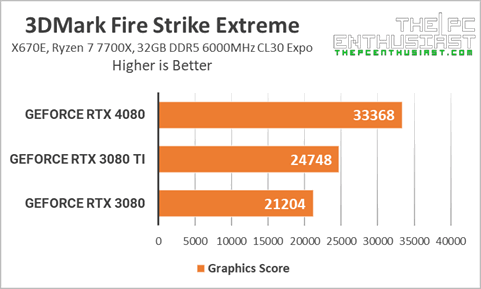
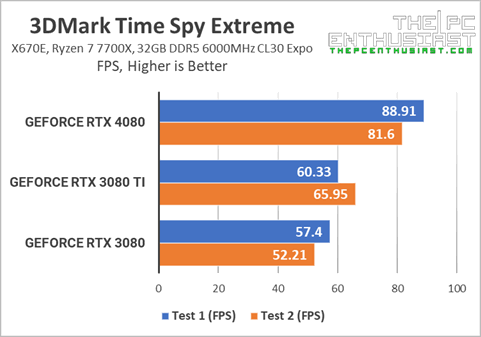


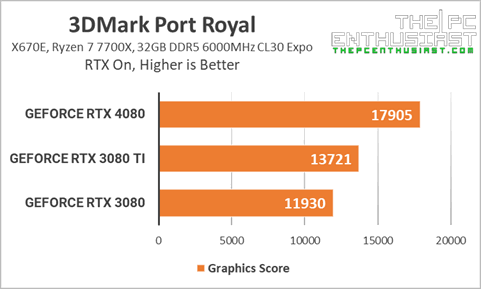
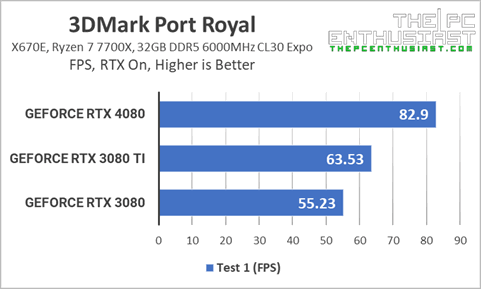
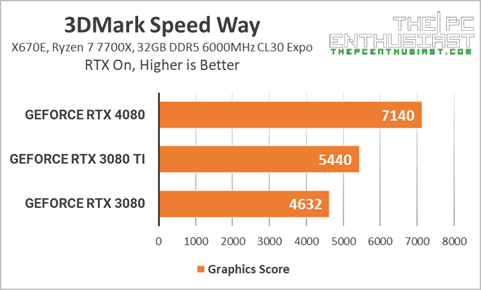

Using 3DMark’s benchmark suite, the GeForce RTX 4080 is almost double the performance of its predecessor, the RTX 3080. Meanwhile, the RTX 3080 Ti sits somewhere in between, closer to the RTX 3080 than the 4080. Based on these synthetic benchmarks, we can conclude that the RTX 4080 is significantly faster than the RTX 4080. Even if we compare the RTX 4080 to the RTX 3080 Ti, there’s still a huge performance gap.
But these are synthetic benchmarks, and they may not represent the performance of real games. So let’s check them out below.
RTX 4080 vs RTX 3080 (Ti) – Game Benchmarks
Cyberpunk 2077
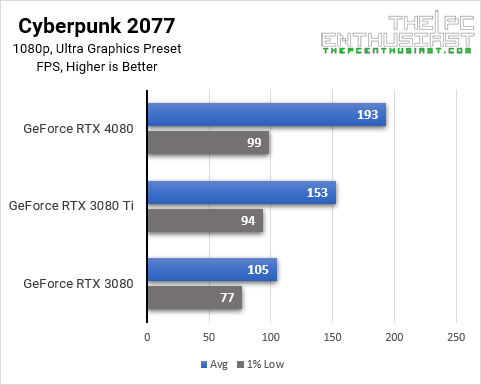


Let’s start with one of the most demanding titles – Cyberpunk 2077. It’s very GPU demanding that even without ray tracing, it’s pretty difficult to get higher frame rates in 4K without the help of DLSS or by lowering the graphics settings.
The RTX 4080 performed around double the performance compared to the RTX 3080. Meanwhile, the RTX 3080 Ti sits somewhere in between.

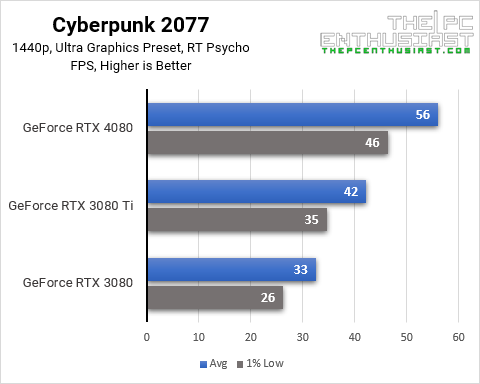
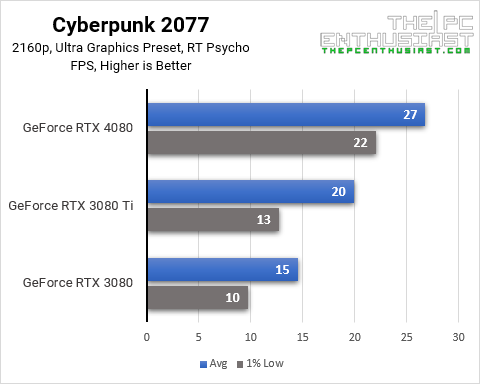
When I enabled Ray Tracing with Psycho settings on top of the ultra graphics preset, it brought the graphics cards to their knees. Even the RTX 4080s didn’t even reach 30 fps in my test. With a framerate of around 30 fps or below, it felt really sluggish, and the gaming experience was not good at all.
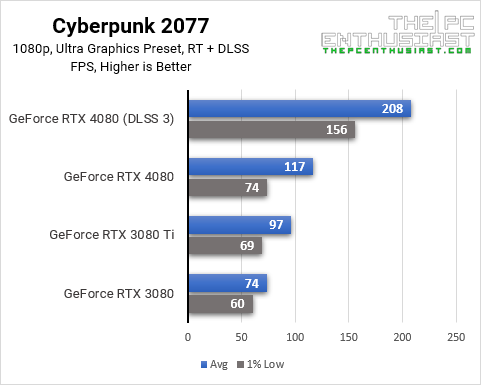

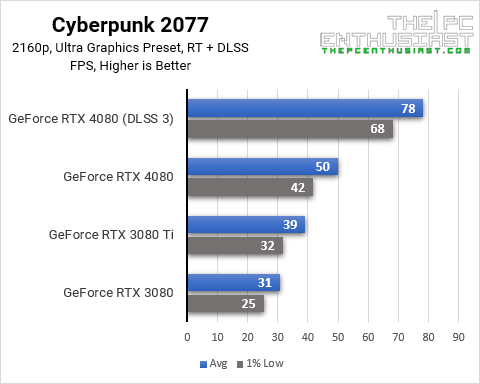
But after enabling DLSS, the frame rate got better. We can see a much playable frame rate at 2160p and 1440p. The RTX 3080 and RTX 3080 Ti were hovering around 30fps or more at 4K UHD resolution. Meanwhile, the RTX 4080 is still below 60fps at 4K resolution. You can get a higher frame rate if you opt for DLSS performance, but I prefer the look of DLSS quality.
The RTX 40 series GPUs have a trick under their sleeves. It’s called DLSS 3 with AI frame generation. As mentioned before, it creates a frame and inserts it in between. It’s like DLSS 2 but on steroids. As you can see from the results above, both the RTX 4080 graphics cards achieved an average of 78 fps. That’s around double the performance of what the RTX 3080 Ti can do and more than double of the RTX 3080.
Unfortunately, DLSS 3 is only available in the RTX 40 series lineup. And the older RTX 30 and RTX 20 series GPUs do not support DLSS 3. Maybe in the future, but maybe not. Time will tell.
A Plague Tale: Requiem
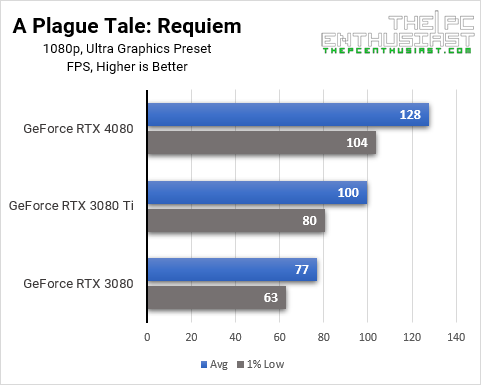
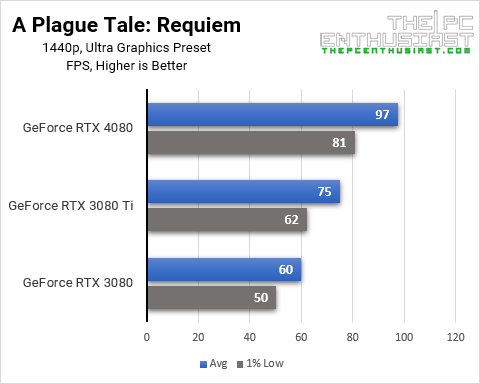
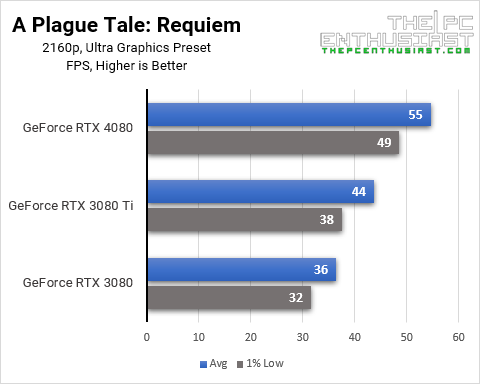
A Plague Tale Requiem is another very demanding game. Although the graphics look nice, I don’t know why it’s so heavy and graphics intensive. When the game starts, and you have control of the character, the frame rate starts tanking for the RTX 3080 and RTX 3080 Ti. The RTX 3080 and 3080 Ti can still manage more than 60 fps at 1080p and 1440p. But both felt sluggish at 4K resolution. Meanwhile, with ultra graphics quality, the RTX 4080 cards can barely reach 60 fps at 4K resolution.

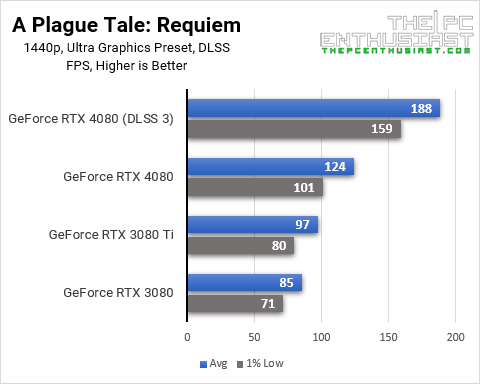
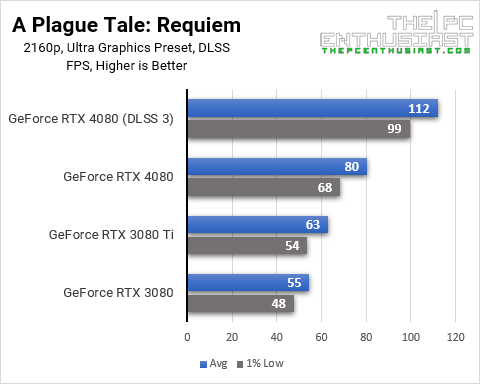
After enabling DLSS, we can see improved frame rates for the three graphics cards. But with RTX 4080’s DLSS 3, more frames are being generated, and we see a significant performance increase from DLSS 2. The RTX 4080’s frame generation is working like magic. And with NVIDIA Reflex, the game feels more responsive and smooth.
So far, only Cyberpunk 2077 and A Plague Tale are the titles I have tested with DLSS 3. I didn’t notice any weird artifacts or distortions on the image while DLSS 3 was enabled. But other reviewers have reported that they noticed some weird artifacts, or glitches, around a moving character or object. I’ll look more into DLSS 3 in a separate article in the future.
Call of Duty Modern Warfare II

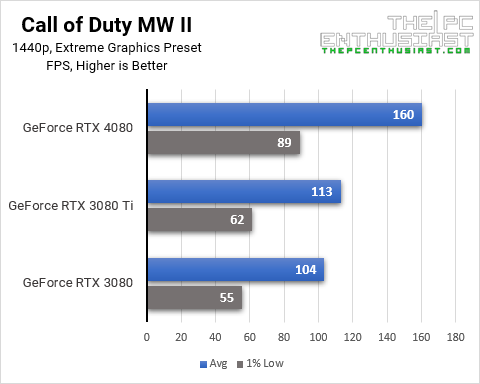
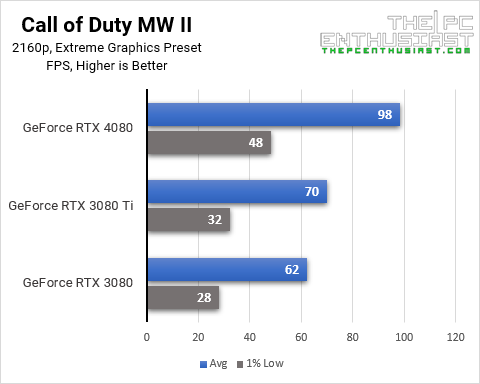
I don’t consider Call of Duty Modern Warfare II a very demanding or graphics-intensive game. However, since this is an FPS game and having a high frame rate matters, you may need to tone down the graphics settings to achieve more than 100 or 200 fps. There are a lot of graphics optimization guides out there, especially if you are playing multiplayer mode.

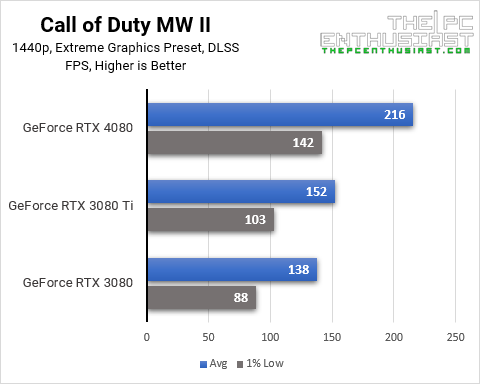
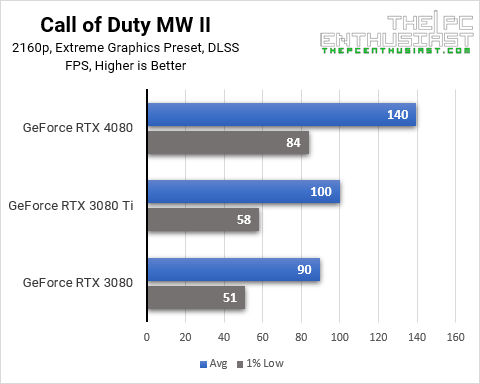
If you need those frame rates high, enabling DLSS really helps. I used the DLSS quality preset when I benchmarked CoD MW II, so if you use DLSS performance, expect to get even higher frame rates.
At 4K resolution, the RTX 4080 is more than 55% faster than the RTX 3080 in traditional rasterization and when DLSS is enabled. Meanwhile, there’s a 40% performance difference between the RTX 3080 Ti to the RTX 4080.
Forza Horizon 5
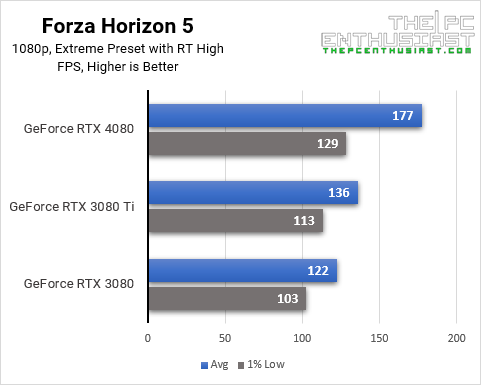
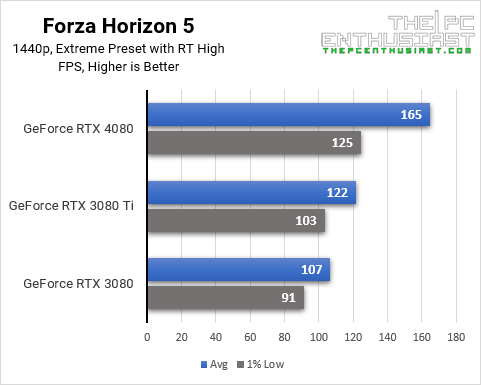
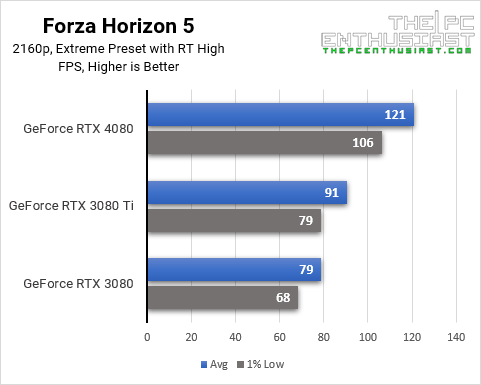
In Forza Horizon 5, again, we can see a more than 50% performance increase from the RTX 3080 to the RTX 4080. It is not double the performance, but it is still a significant jump.
Watch Dogs: Legion
I tested Watch Dogs Legion in traditional rasterization, with ray tracing (only), and with ray tracing and DLSS. Like the games above, I used the highest graphics settings or ultra quality. I also used ultra for ray tracing and quality for DLSS.
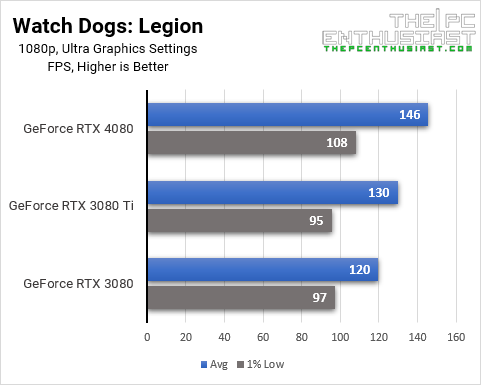
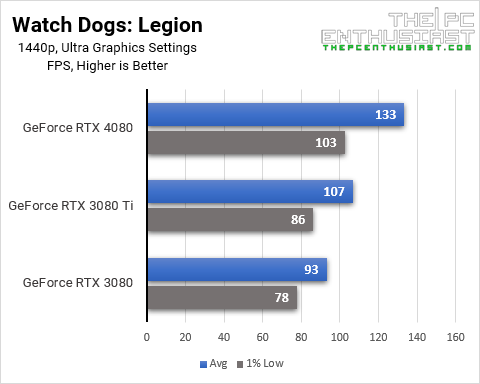
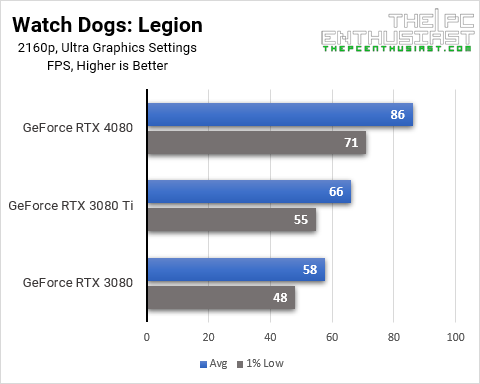
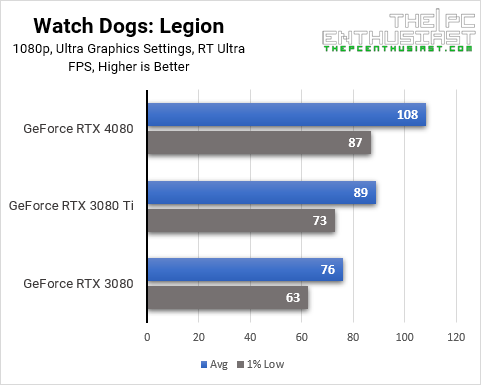

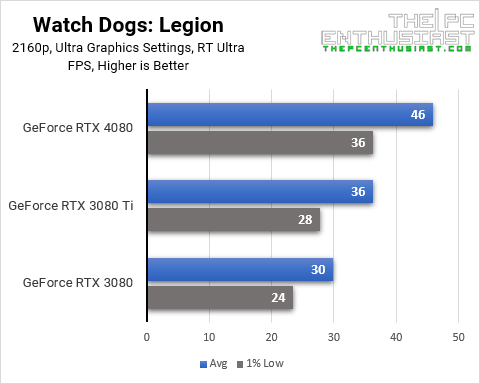
Watch Dogs Legion is one of those games where you need to use DLSS when you want to enable ray tracing. As you can see from the results above, the RTX 3080 can only achieve around 30 FPS in 4K. Meanwhile, the RTX 4080 can’t even reach 50 FPS.
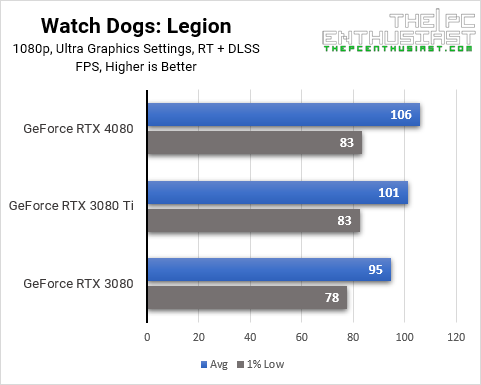
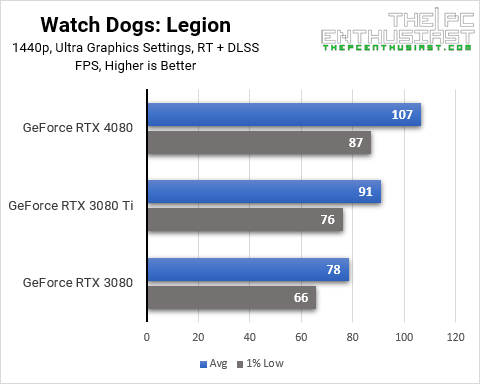
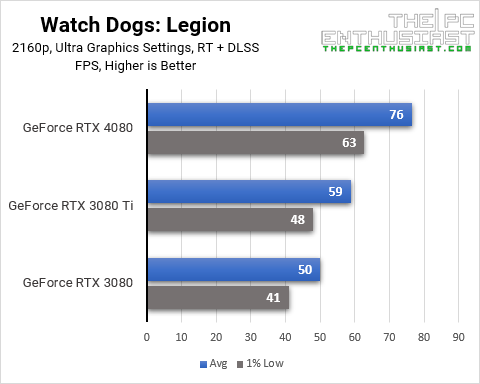
Enabling DLSS will get you above 60 FPS with the RTX 4080. The RTX 3080 Ti can barely maintain 60 FPS, and the RTX 3080 trails behind even with the help of DLSS. Of course, lowering ray tracing quality and using DLSS performance will help with the frame rate.
I will not show you all the games I tested here, as that will make this article too long. But if you are interested, check out our review of the MSI GeForce RTX 4080 SUPRIM X here and our Zotac GeForce RTX 4080 Trinity OC review here. You can find the rest of the charts in those reviews.
RTX 4080 vs RTX 3080 and RTX 3080 Ti Summary Results
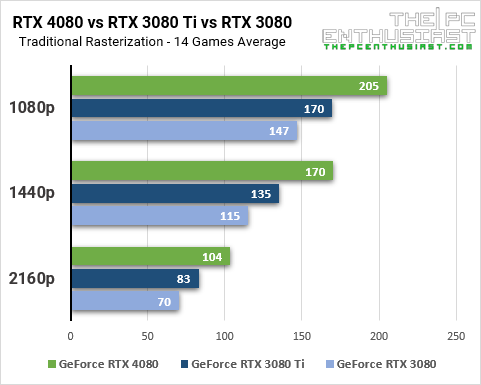

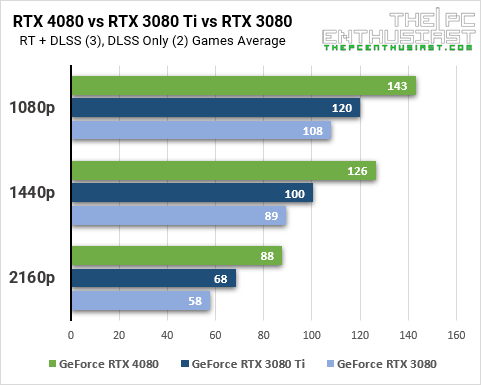
In summary, the RTX 4080 is around 40% to 50% faster than the RTX 3080 on average in traditional rasterization. This is with the 14 games that we tested. Meanwhile, the RTX 4080 is only around 25% faster than the RTX 3080 Ti in traditional rasterization.
If we consider ray tracing and DLSS, that will make the RTX 4080 around 32% to 52% faster than the RTX 3080 on average. Now, this is only for DLSS 2. I haven’t included DLSS 3 since I could only test 2 games with DLSS 3. Soon, when more games have DLSS 3, we will revisit this comparison.
However, with DLSS 3 enabled, expect that the RTX 4080 will have an (unfair) advantage over the RTX 3080 and even the RTX 3080 Ti. Finally, let’s discuss their pricing.
Pricing Difference
The GeForce RTX 4080 starts at $1,199. That’s the price of the Founders Edition or any RTX 4080 with base model specs. However, expect that custom graphics cards from NVIDIA’s partners will sell their RTX 4080 at a higher price. On top of that, some retailers jack up the price, making it almost priced as an RTX 4090. If that’s the case, it’s better to get the much faster RTX 4090 instead. The RTX 4090 starts at $1,699, by the way.
While I am really impressed with the RTX 4080’s performance, especially with DLSS 3 and dual AV1 NVENC encoders, I am sad about how NVIDIA priced this GPU. The RTX 4080 is more than 70% more expensive than the RTX 3080. That’s just based on the starting MSRP, $699 to $1,199. It is also the highest price increase from an XX80-class GPU.
Just check out the starting prices or MSRP of the previous XX80-class GPUs. There’s no excessive increase from the GTX 980 to RTX 3080. Meanwhile, there’s a $500 difference between the base price of the RTX 3080 and the RTX 4080. So, while we got much better performance with the RTX 4080, we’re also paying for more.
- GTX 980 – $549
- GTX 1080 – $599
- RTX 2080 – $699
- RTX 3080 – $699
- RTX 4080 – $1,199
UPDATE: Unfortunately, for the older RTX 3080 and RTX 3080 Ti, their current retail prices are all over the place. It’s 2023, and I don’t see RTX 3080 and RTX 3080 Ti prices dropping like a rock. Currently, an RTX 3080 sells for around $900 to $1,500, depending on the model and retailer. Meanwhile, the RTX 3080 Ti retails from about $1,150 to $1,600, depending on the model and/or retailer.
Fortunately for the newer RTX 40 series cards, retailers are selling them at SRP. I see RTX 4080 and RTX 4070 Ti cards starting at $1,200 and $800, respectively.
GeForce RTX 4080 vs RTX 3080 (Ti) Conclusion – So, Which One? (Updated)
If budget is not a concern and you want the latest and greatest, it’s better to get the GeForce RTX 4090. The cheapest yet good quality I see is the MSI GeForce RTX 4090 Gaming X Trio, currently retailing for $1,650 USD. You can also check out some of the best RTX 4090 cards here.
If you don’t want to spend more than $1,500 for a graphics card, the RTX 4080 retails for around $1,200++ at the time. You can check out some of the best RTX 4080 cards here. However, the RTX 4070 Ti is also a good option, starting at $800. But the RTX 4070 Ti is more of a 1440p graphics card rather than 4K; still, it is a 4K capable graphics card. It is, after all, faster than the RTX 3080 and slightly faster or on par with the RTX 3080 Ti. You can check the data from our review of the RTX 4070 Ti here.
Unfortunately, with their current pricing for the older RTX 3080 and RTX 3080 Ti, I can’t recommend that at all. Not unless prices for these older generation cards start dropping substantially, below their original MSRP. Even the RTX 4070 Ti is a better option, in my opinion, thanks to newer features like dual AV1 NVENC and DLSS 3.
The only reason I would recommend the older RTX 3080 or RTX 3080 Ti is if you plan to buy an EVGA graphics card, perhaps for collection. Remember, both the RTX 3080 and RTX 3080 Ti are outgoing GPUs. I wouldn’t pay for more than what they should be. Some retailers still take advantage of the market and sell them at a higher price.
I hope this article helps. Please share this article with your friends. And let me know what graphics card you plan to buy, especially since Black Friday and the holiday season are just around the corner.
Check the latest pricing and availability: (#ad)
RTX 4090 graphics cards available on Amazon.com here, or Amazon.UK here.
RTX 4080 graphics cards available on Amazon.com here, or Amazon.UK here.
GeForce RTX 3080 Ti available on Amazon.com here or at eBay.com here.
GeForce RTX 3080 available on Amazon.com here or at eBay.com here.

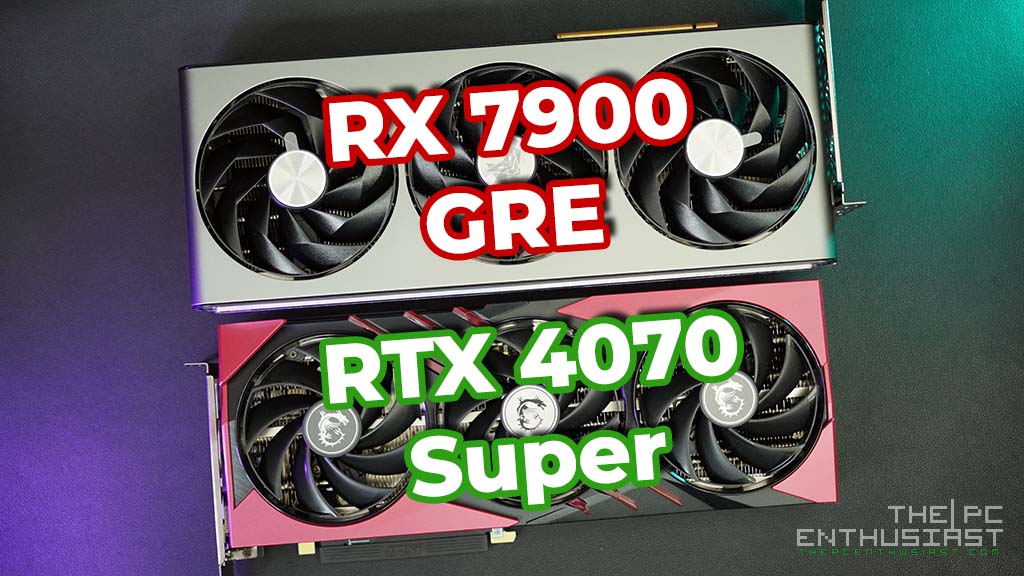
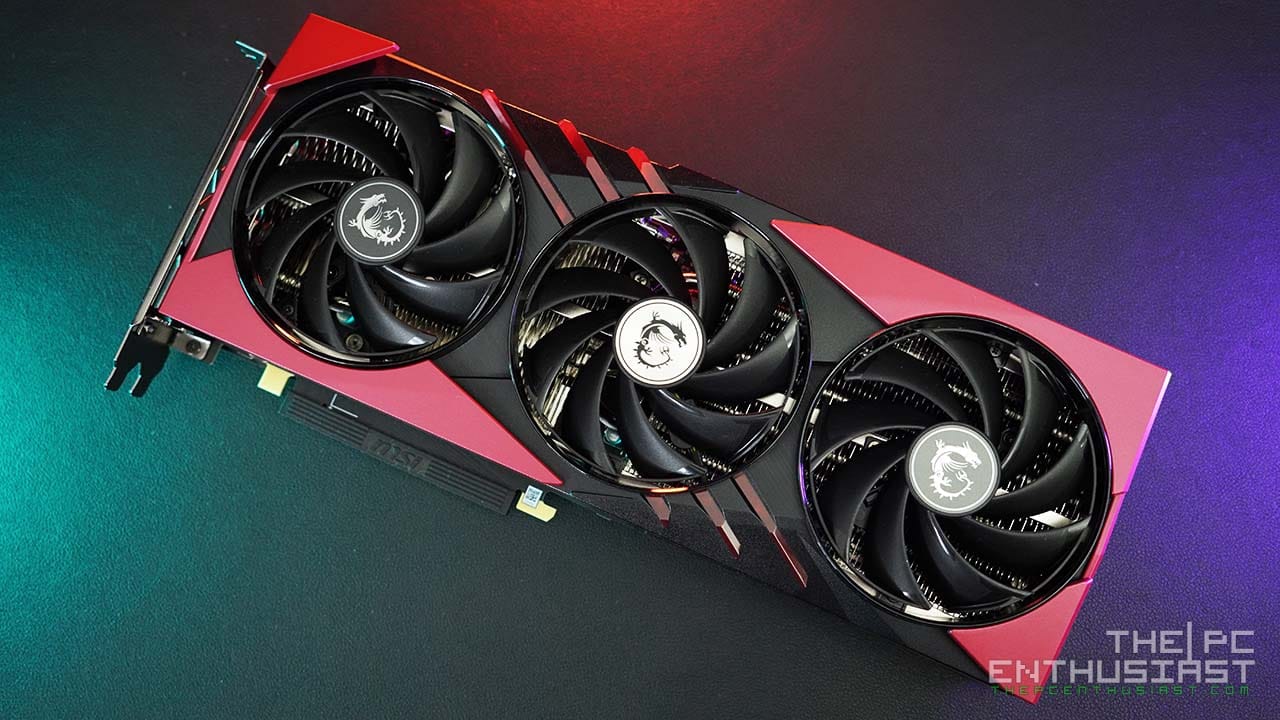
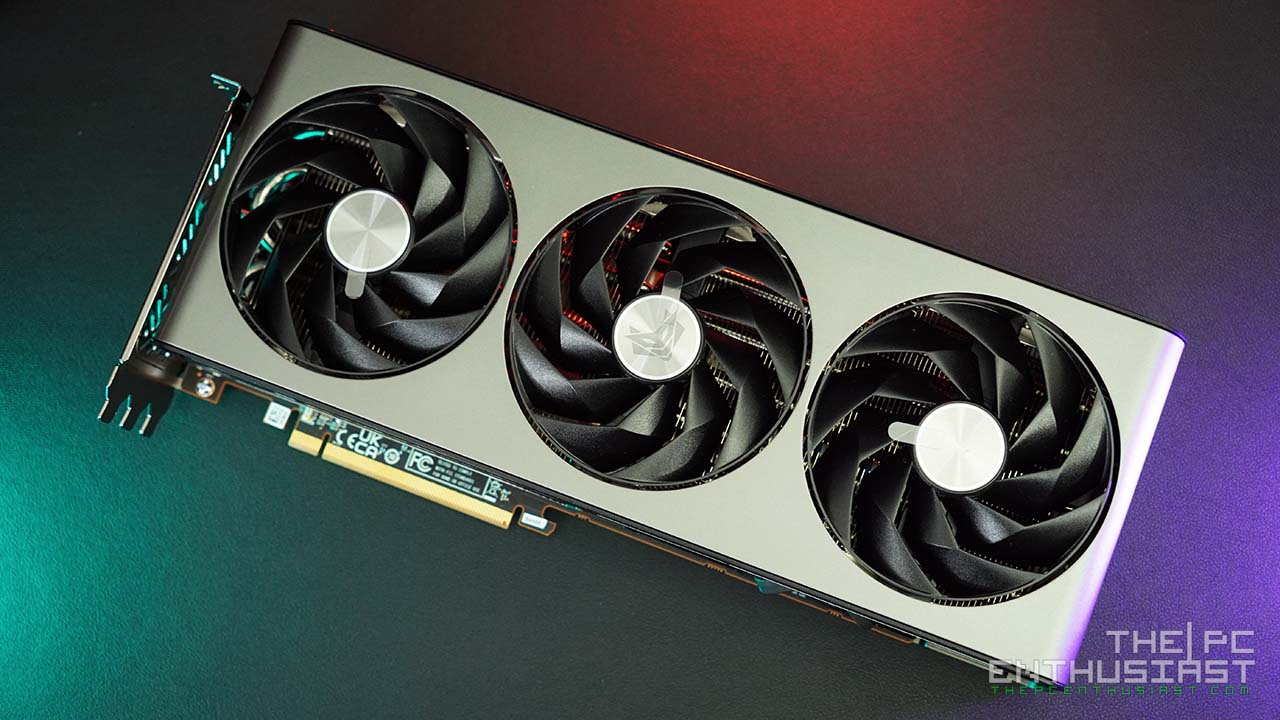

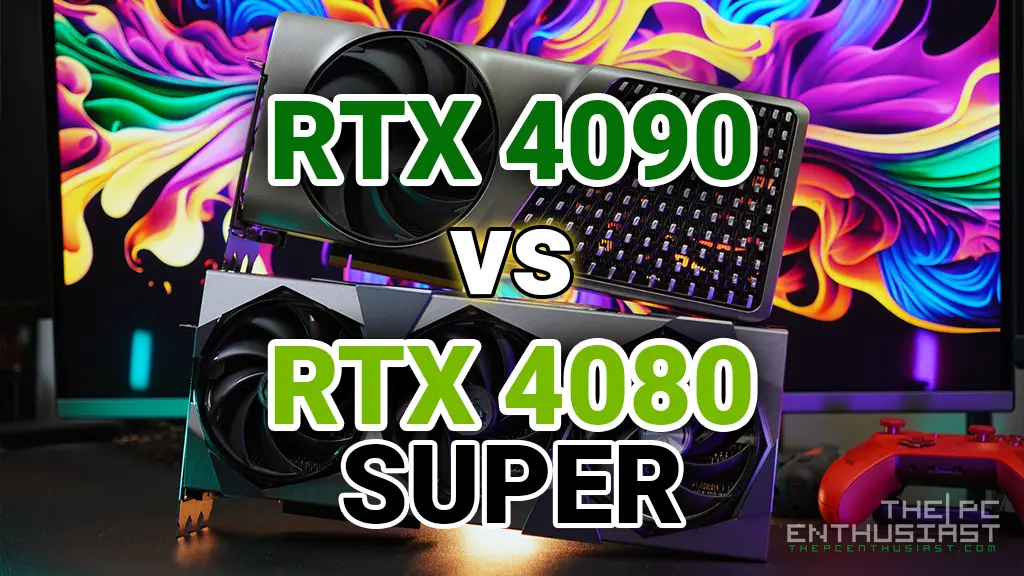
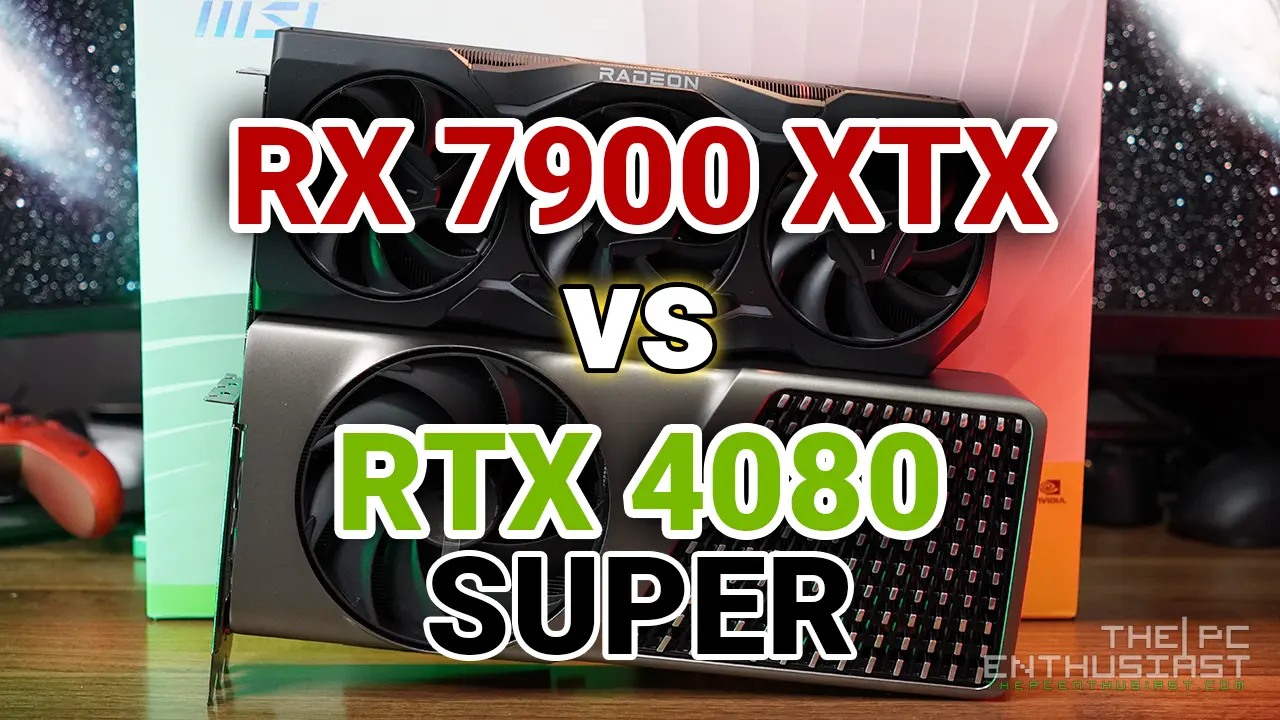

I just replaced EVGA 3080 ti with TUF-RTX4080-O16G-GAMING. I like this article and absolutely believe it. The games I play are Halo Infinite, Halo Master Chief, Doom Eternal and the remastered Crysis games. I got 120 FPS on all those with the 3080 ti and that is what I am getting ing on 4080. Not sure why no change? Also, Nova Bench not showing improvement. Would appreciate any feedback.
Hi, lots of unknown factors.
But did you remove the old driver, using DDU, and install the latest driver for the RTX 4080?
I haven’t tested the RTX 4080 with the games you mentioned. So, I don’t know how much difference should you expect.
What resolution are you using and what’s the specs of your PC?
Thanks for the reply. I did manually remove all EVGA and Nvidia software but did not use DDU. I will try that. I am using 4K 120. Asus z690, 12th gen I9, hx1500i PSU windows 11. 64GB DDR5. Thanks
Seems like you are manually limiting it if you’re capping at 120FPS
Yes, also another reason. Still, there are a lot of unknowns. I tried it before, exchanging graphics cards without uninstalling/reinstalling drivers; performance should change.
Every new generation is better than old generation.
do you have v-sync turned on??
that would cap you at 120 due to refresh rate
“I am using 4K 120”